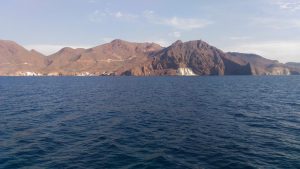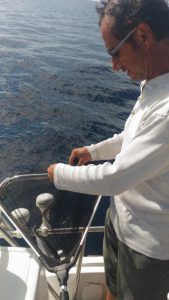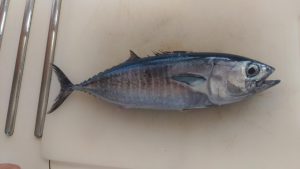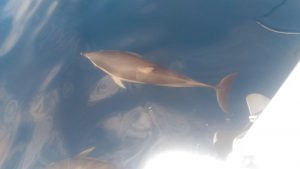When we left Tarragona on 11 September, our plan was to sail all the way down to Alicante, a city I absolutely wanted to visit because I had stayed there for a month studying Spanish when I was 18. This trip would take several days. I had suggested, and Pierrick agreed, to a new shift division: he does 10 pm to 2 am, then I do 2 to 4, he then does 4 to 6 and I finish the night from 6 to 10 am, so 4-, 2-, 2-, 4-hour shifts. This way we could respect our natural tendencies, he being a night owl and me a morning bird, and avoid the usual 2 or 3 hour shifts throughout the night.
All things considered, our trip went well. Occasionally the winds died down so much that we brought them in a motored our way. When we did have wind, it was mainly from the South-East, giving us a close reach wind to sail under. We were keeping good speed as we crossed the Golf of Valencia, but night was falling for a second night at sail and our route would have us approach the coast, especially at the Cabo de la Noa where there is a separation zone that marks where tankers should pass. Coastal sailing means extra vigilant night watches to avoid fishing nets (that can do horrors to your motors propellers) and fishing boats, that go out at all hours and do not necessarily light their navigation lights or generate their AIS signal (so that competitors won’t know where they are getting their catch). In addition to all this, coasts that have many constructions, such as in Spain, generate a lot of light, which has the opposite affect of making the night sea less visible. With all these factors, we decided to anchor for the night and tackle Cabo de la Noa under daylight.
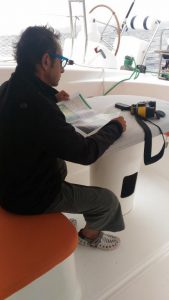
Cala Sardinera, South of the beach of Javea, has practically no descriptions in any of our guide books. It’s by looking at the map that I deduced that it must offer good shelter from the swell. We approached past sundown. Several boats were already anchored. Strangely, the cala was filled with yellow buoys that looked like those used to delineate swimming zones, except these ones were seemingly laid out any which way. We anchored, steering well clear of the other boats and the strange buoys, and slept soundly. It was only the next day that we noticed that the buoys were for mooring. It seems the Spanish coast has added many such buoys in their calas, which is a good thing as having set buoys instead of anchors constantly being set and pulled up helps preserve the sea floor.
The next day, 13 September, there was no wind so we motored out of the Costa del Azahar and into the Costa Blanca to Alicante where we stayed for two nights.
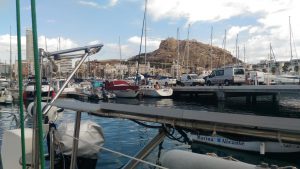
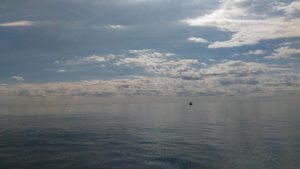
The trip from Alicante to Cartagena, a city Pierrick wanted to visit, was meant to be a full day on the boat. We left Alicante on the 15th a little before noon. Our trip started by motor, but by mid-afternoon the winds rose and we opened our sails. We were getting a Southern or South-Western wind, force 3 to 4. Unfortunately, the sea rose up with the wind. The sea state went from calm to rough. This in itself wouldn’t have been a big deal had it not been for the fact that catamarans do not sail well at close wind. We did several tack changes in the bay between Alicante and Torrevieja, but after several hours with little advancement, we brought in the sails and put the motor back on. We had estimated our time of arrival in Cartagena to be 8 PM and it was already 9.
There is another separation zone at the Cabo de Palos, the point that separates the Mar Menor from Cartagena. While sailing in the bay between Torrevieja and Mar Menor, we noticed that some tankers were following the coast rather than a direct route from one separation zone (Cabo de la Noa) to the next.
“Why would tankers deviate from a straight route and follow the coast?” Pierrick wondered out loud. I had been asking myself the same question. “They must know something we don’t,” was my response. A little while later, Pierrick noticed that our SOG (speed over ground – so the actual speed at which our boat was advancing) was of 3 knots, and not the 5.5 knots speed at which our motors were working. In addition to the choppy waters that were making the trip less than fun, we had forgotten to take into account the current that was working against us and lowering our speed. “That must be why the tankers pass along the coast. To avoid the current.”
By 1 AM, I had taken over the couch in our galley and dosed off while Pierrick handled the seas. I missed our entrance into the majestic and natural port of Cartagena. He awoke me at 4 AM to help anchor the boat in the marina. I had called ahead of time to announce our arrival. The Yacht Port had assured me that marineros were there to help until 11 PM, after which the security guard could lend a hand. It was the security guard who helped us dock. Finally, at 4:30 AM, after a long and hard day at sea, we were docked in a safe shelter.
And that’s about when the cat started throwing up. Apparently my shift was up. Pierrick went to sleep while I stayed awake until 6 cleaning up Moody’s sick and trying to calm him down. Poor kitty.
We left Cartagena on the 20th amid gray & cloudy skies and rough seas. Four big military boats left the port at the same time we did as well as a huge red tugboat that was the impressive size to rescue commercial tankers. Our objective was to sail to Almerimar, but seeing the state of the sea and as the winds died down by early afternoon, we decided to call it a day. We found another excellent anchorage just North of Punta del Cerro de la Cruz. The Ensenada de la Fuente is surrounded by white sand at the base of the beautiful Mount Cope. We shared the anchorage with one other boat from Sweden, the owners of which played the guitar in the evening and had aboard a big German Sheppard.
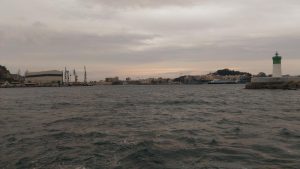
The 21 September was a day devoid of wind, so we motored our way down the coast at a speed of around 5 knots. Our objective of Almerimar was still too grandiose; we made it to the Cabo de Gata, the last major point before the Costa del Sol. We arrived after sundown at Puerto Genovés, just North of Cabo de Gata, which is not actually a port but a small and shallow bay with a sandy bottom. About three other boats shared our anchorage, but thanks to its shallowness, we were well dispersed.
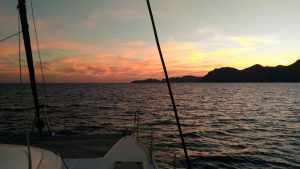
In the South of Spain, days are already becoming shorter. The sun sets at around 8 PM and rises at 7 AM. Days are hot when the sun shines hard, but evenings are cool, especially when windy. The dog days of Tarragona are well behind us. We are now close to the Moroccan coast. We can’t quite make it out because visibility is not that great, but we’ve started to hear more French messages on our boat radio.
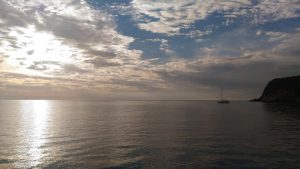
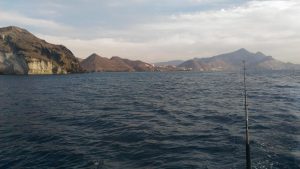
We left our anchorage this morning by gentle seas. We have just contoured the Cabo de Gata. Winds are Western, directly behind us, so another day motoring is expected. Luckily the current is with us, pushing us towards Motril, the destination we wish to reach before the day’s end.
